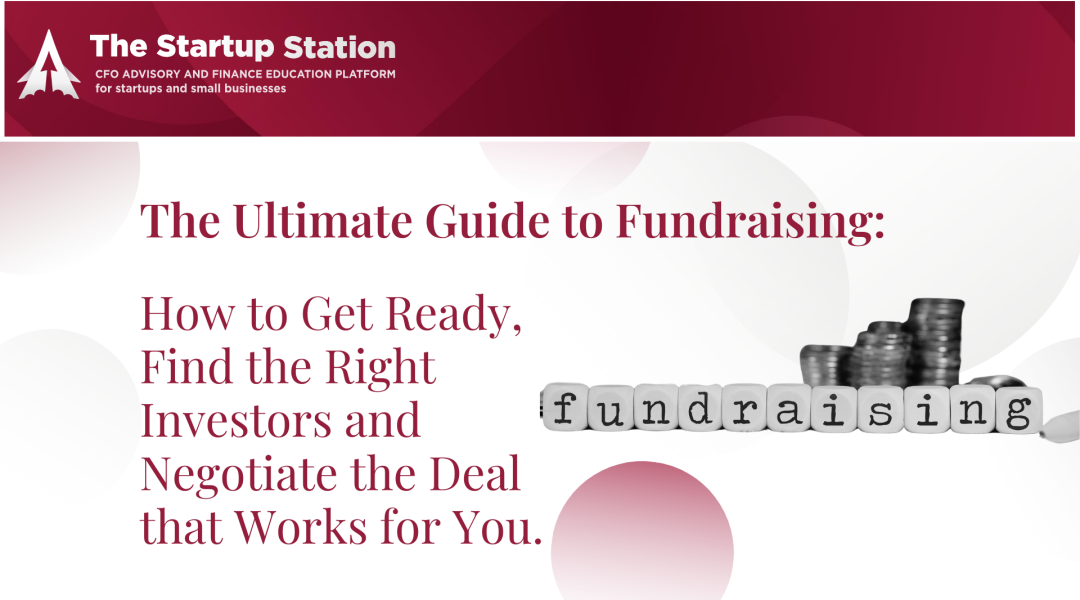Fundraising is a daunting challenge, even for the best finance professionals, and downright scary for startup founders with no finance experience. According to Fundable and Entrepreneur, 565,000 startups are launched every year and just under 3% receive angel and VC investments.
That is why we decided to dive into this subject in the next three months in three parts:
GETTING READY
Our first section is focused on what you need to do before you start looking for investors.
“Rome wasn’t built in a day” and it takes time to prepare for fundraising and make sure that all your ducks are in the row. You need a compelling pitch deck, a financial model adapted to your stage and business model, and incorporation and other legal documents.
LOOKING FOR INVESTORS
When I meet first-time entrepreneurs, almost every initial conversation eventually turns to “How and where do I look for investors”? It’s the elephant in the room. It’s Everest all founders looking for funding must climb, whether or not they know how to rock climb and whether or not they have experience with extreme temperatures and altitude.
This is why our second section is focused on different approaches of looking for investors as well as how to understand their feedback and effectively address their concerns.
NEGOTIATING YOUR TERM SHEET
For any early-stage startup founder, there are several key moments that mark the trajectory of the company’s growth and serve as a testament to the founding team’s hard work. It could be the MPV launch, your first customer, and, of course, your first term sheet.
Sadly, not all term sheets are created equal and sometimes, as difficult as it is, sometimes it is better to walk away from a deal than to take it and jeopardize your company’s future.
That is why in the final section we focus on startup finance and situations that you should watch out for in investor negotiations.
PART 1. GETTING READY
Getting ready for fundraising is like preparing for a marathon. It requires meticulous planning, strategic thinking, and the right tools in your arsenal. In this section, we delve into the essential steps every startup founder must take before embarking on the fundraising journey. From crafting a compelling pitch deck to ensuring legal compliance, we provide actionable insights to help you lay a solid foundation for your fundraising efforts. This part of the guide equips you with the knowledge and resources to navigate the complex terrain of startup finance with confidence and ease.
-
Top Three Fundraising Mistakes
If you’re diving into the world of fundraising for the first time, it’s totally normal to feel a mix of excitement and anxiety. However, some of the mistakes are common even for the experienced founders. This video will guide you through the pitfalls and help you navigate the path to funding success and do it fast.
-
What Do Investors Look for?
Once you decide to fundraise, it is important to understand the investors’ mindset, what they are looking for, and make sure you meet investment eligibility criteria.
Investors aren’t just interested in flashy products—they’re after businesses with serious growth potential. While some may have noble secondary goals, like backing female-led ventures or green innovations, the bottom line is always about profit and managing risk.
Watch this video to learn which five main criteria early stage investors use when conducting their due diligence.
-
How to Make Your Pitch Stand out?
It is important to tell your story the right way and to back it up with solid numbers you can justify. Public speaking jitters can strike even the most confident people, but for startup founders, the pressure is on a whole new level. You’re not just presenting for the sake of it— you’re laying your heart and soul on the line, pitching the culmination of months of hard work and passion.
In this video, we’re diving into four game-changing strategies to captivate investors and fast-track your funding journey.
-
What Do Investors Look for in Your Financials?
Finally, the numbers. Watch this video to understand how to create and use your financial projections so that you can explain to investors how you plan to turn your vision into reality. We will go over the most common investor questions, why they ask it and how to best answer them.
PART 2. LOOKING FOR INVESTORS.
Investors are not running a charity. The reason why investors make investments is that they believe they will make a profit. For them, it is a business transaction that is researched heavily and thoroughly thought through. This further means that investors want to know the business they are bankrolling really well and minimize their risk as much as possible. Thus, knocking randomly on their digital doors to ask for cash is not the best way to get funded fast. In fact, contacting investors only when your company needs capital will elongate the search needlessly.
After speaking with multiple investors, The Startup Station recommends a far more successful way to secure funding faster by building relationships with investors three to six months before you actually need it. We discuss it further in this blog and video.
-
The Best Way for a Startup to Get Funded Faster is to Build Successful Relationships with Investors
This is all great advice, but if you are fundraising for the first time, finding which investors you need to be building relationships with can still be a challenge. Where do you go? What do you say? How do you get their attention effectively?
In the video below, we talk about the following five ways you can raise capital even if you don’t have a network:
- Utilizing your network
- Applying to an accelerator
- Entering a pitch competition and attending startup conferences and events
- Using crowdfunding, and
- Applying to an angel group
-
How to Look for Investors if You Don’t Have a Network
Getting investors feedback is crucial to honing your pitch and assessing if you are targeting the right investors and meeting their eligibility criteria.
However, sometimes investors’ feedback can be confusing and while you understand it is a “No” or “Not right now”, you may not know exactly what to do about it to get a different response.
What does it actually mean when investors say, “You are too early”. “Come back when you have traction”. “We already invested in a similar company before.” This is exactly what we address in our next video
-
Most Common Investor Rejections and What They Really Mean
Finally, we wanted to talk about the gender funding gap. Did you know companies with at least one female cofounder generate 78% more revenue per invested capital and deliver 2.5x revenue than male founded counterparts?
Yet, female-led companies get very little capital allocation from VC and PE firms worldwide. Globally, women entrepreneurs only raise 2% of overall available VC funding. Further, women led companies have limited access to mentoring and advising resources to guide them.
In this blog, we talk about five most common challenges female entrepreneurs face and how to overcome them.
PART 3. NEGOTIATING YOUR TERM SHEET
So now that you got ready for the fundraising and found the investors who are your allies, what’s left? Negotiate the best deal possible. Investors have been through this millions of times, they know how to look out for their interests. Do you? After reading this part of our guide you will learn:
- Three main financing vehicles used to fund startups
- When to do investors offer you too much or too little money, and
- When to walk away from the deal
1. Introduction to Startup Finance and the World of Term Sheets. How to Understand what Works for You?
Raising money is an arduous journey for any first-time entrepreneur, and thus getting that first term sheet from a professional investor is an incredible validation of your vision, product quality, and persistence.
However, money needs to come in on the right terms and in the right form. Here are the three main startup financing vehicles to help you choose what might work best for you:
Equity: Equity represents company ownership and is determined as the capital required divided over pre-money company valuation. The catch here is that it is NOT easy to value an early stage company. As a result, the investors and founders may have vastly different ideas of how much a company is worth, which, of course, makes it very hard to agree on what equity stake investors should get.
To solve this problem, investors came up with two other financial vehicles which delay a company valuation until a later point when more data is available.
Convertible Debt: A debt instrument that converts to equity based on certain rules and upon occurrence of certain events, or triggers. You will have to value your company only when the conversion happens, but not before.
Important to know: In the event of non-conversion, you MUST repay the outstanding principal together with accrued interest on the due date. You can also repay both at any time before the due date and before the debt converts.
Investors love this financial vehicle because it helps them mitigate risk in the event of non-conversion, or when the company is not doing well. For comparison, if they made their investment in the form of equity, they would simply lose their investment. Now, they can get it back PLUS interest.
This, of course, is not great news for startup founders. In fact, if not structured properly, this vehicle may cause a lot of problems for the company and even make it more difficult to raise money in the future.
Simple Agreement For Future Equity (SAFE)
This financial vehicle is similar to convertible debt, but without a debt component. Like convertible debt, it converts to equity based on certain rules and upon occurrence of certain events, or triggers. Just like with convertible debt, you value your company only when the conversion happens, but not before.
However, when a SAFE does not convert, it simply remains outstanding, unless there is a provision that forces conversion after a certain period of time.
We recommend this vehicle as opposed to convertible debt, precisely because it does not need to be repaid in the absence of a triggering event.
Read this blog and watch the video below for more details about the three main financing vehicles.
Now that we discussed three main ways in which you can take money, let’s talk about other aspects of the deal.
-
Introduction to Startup Financing: Equity, SAFE, and Convertible Debt
2.What If Investors Offer too Much or too Little?
What do we do if the deal that we get is not what we asked for? Is it a threat, a wake-up call, or an opportunity?
In both cases, when a round is oversubscribed and undersubscribed, it is important to consider legal and financial implications of the offer.
Here are some of the questions to ask your legal and financial teams:
- What other conditions are involved in taking this deal?
- How many seats on the board do they want?
- What control do they want to have over what decisions?
- Are there other conditions that may make raising future rounds of capital more challenging?
- How does this raise affect your long-term strategy? Will you be able to continue to reach future milestones?
Watch the video below as I walk through these considerations in more detail.
-
Founders’ Dilemma: Investors Offer too Much or too Little
3. When Should You Walk away from a Deal?
For any early-stage startup founder, there are several key moments that mark the trajectory of the company’s growth and serve as a testament to the founding team’s hard work. To name a few, these are the MPV launch, your first customer, and, of course, your first term sheet.
Sadly, not all term sheets are created equal and sometimes, as difficult as it is, it is better to walk away from a deal than to take it and jeopardize your company’s future.
There are three situations which warrant you saying “No” to investors.
- Unfair valuation terms
- Investors want too much control
- Disadvantageous anti-dilution rights
In this blog, and the corresponding video, we discuss these situations in more detail.
-
When Should You Walk Away from a Deal?
4. Liquidation Preference – is it Always a Deal Killer?
The fourth situation is when investors require liquidation preferences.
A liquidation preference is a clause in the Term Sheet that dictates the payout order. It is there to protect investors in case of a liquidation event and, in certain cases, receive cash from their investment faster.
There are two types of liquidation preferences: participating (in the upside) and not participating. Participating liquidation preferences will get their investment and the bigger of the required return of investment and their prorated share of proceeds based on their equity ownership . Non-participating liquidation preferences limit the investors’ payback to the original invested amount plus the required return.
Lately, there has been a new wave of liquidation preferences. Such preferences specify paying out investors not only in case of liquidation events, but also upon reaching financial milestones, such as certain revenue or operating cash flow. Those clauses pose great danger to founderse because instead of investing in growth of the company, a startup is forced to start paying investors back early from the very money they need to grow and succeed.
Learn more about the liquidation preferences in the video below.
-
Liquidation Preference – is it Always a Deal Killer?
This guide covers the most common and important things you need to know through your fundraising story. However, all startups and all journeys are different. So, if you have any more questions about fundraising, we are happy to talk. Schedule your free 30-min consultation HERE.
Still have questions?
We are happy to talk to you. Book a FREE 30-min consultation now by pressing the button below and, as a bonus, we will send you a COMPLIMENTARY financial health checklist.








 “Coming in with no formal background in financial modeling or accounting and as a first-time founder, I needed exactly this program. Victoria’s financial training covered startup accounting, investor-ready financials, key metrics, and break-even across common business models, presenting and analyzing financials, and term sheets and valuation, which finally made the numbers click. I built a working bottoms-up forecast, clarified our unit economics, and can now speak to the model with more confidence. Jeanne’s investing expertise clarified what investors actually care about, from pitch deck structure to effective cold outreach. Demo Day prep and the Demo Day pressure-tested the narrative and produced actionable feedback. The broader network, from go-to-market to legal, was generous and will remain a source of support. I’m leaving with a credible model, a sharper deck, a focused target list, and a clear plan I’m already executing!”
“Coming in with no formal background in financial modeling or accounting and as a first-time founder, I needed exactly this program. Victoria’s financial training covered startup accounting, investor-ready financials, key metrics, and break-even across common business models, presenting and analyzing financials, and term sheets and valuation, which finally made the numbers click. I built a working bottoms-up forecast, clarified our unit economics, and can now speak to the model with more confidence. Jeanne’s investing expertise clarified what investors actually care about, from pitch deck structure to effective cold outreach. Demo Day prep and the Demo Day pressure-tested the narrative and produced actionable feedback. The broader network, from go-to-market to legal, was generous and will remain a source of support. I’m leaving with a credible model, a sharper deck, a focused target list, and a clear plan I’m already executing!” “
“ “
“ “
“

 “If you’re raising capital and want to shine when pitching to investors, I highly recommend you choose Victoria Yampolsky and the Startup Station as your resource for high performance results. Victoria is extremely well versed in all aspects of raising capital and the startup landscape. She provides clients with outstanding tools, applicable advice and thoughtful insights to support their fundraising efforts.
“If you’re raising capital and want to shine when pitching to investors, I highly recommend you choose Victoria Yampolsky and the Startup Station as your resource for high performance results. Victoria is extremely well versed in all aspects of raising capital and the startup landscape. She provides clients with outstanding tools, applicable advice and thoughtful insights to support their fundraising efforts. “Victoria is a rare find in the startup world. She’s brilliant with startup financial strategies and has this no-nonsense work ethic that proves to deliver results. Victoria worked with a participant of 2020 Startups, a startup founder, and within a couple of months the founder raised capital. Victoria has done several workshops and speaking engagements at 2020 Startups and is always insightful and held in the highest regard by the audience.”
“Victoria is a rare find in the startup world. She’s brilliant with startup financial strategies and has this no-nonsense work ethic that proves to deliver results. Victoria worked with a participant of 2020 Startups, a startup founder, and within a couple of months the founder raised capital. Victoria has done several workshops and speaking engagements at 2020 Startups and is always insightful and held in the highest regard by the audience.” “These workshops are extremely useful for all of us. Victoria is the kind of presenter/professional who inspires confidence. I’d recommend her to any startup trying to figure out how it needs to be organized, capitalized, and operated to have a good business model going forward. She focuses on fundamentals, which, too often, are sorely lacking in our ecosystem, and she knows her stuff backwards and forwards”
“These workshops are extremely useful for all of us. Victoria is the kind of presenter/professional who inspires confidence. I’d recommend her to any startup trying to figure out how it needs to be organized, capitalized, and operated to have a good business model going forward. She focuses on fundamentals, which, too often, are sorely lacking in our ecosystem, and she knows her stuff backwards and forwards” “Victoria Yampolsky is THE essential tool for any startup looking to present a viable financial model! If you are a founder who, like me, lacks the business/finance background – YOU NEED HER. If you are looking to show your investors a serious plan for growth and capitalization – YOU NEED HER. Victoria’s thoroughness and dedication will ensure no stone goes unturned in the FOUNDATION of your BUSINESS. And to top it all, she explains everything with such calm & clarity, it is an absolute delight to be working with her.”
“Victoria Yampolsky is THE essential tool for any startup looking to present a viable financial model! If you are a founder who, like me, lacks the business/finance background – YOU NEED HER. If you are looking to show your investors a serious plan for growth and capitalization – YOU NEED HER. Victoria’s thoroughness and dedication will ensure no stone goes unturned in the FOUNDATION of your BUSINESS. And to top it all, she explains everything with such calm & clarity, it is an absolute delight to be working with her.” Liz Wald has 25+ years’ experience building company operations and mobilizing global teams in emerging, disruptive industries.
Liz Wald has 25+ years’ experience building company operations and mobilizing global teams in emerging, disruptive industries.
 Blair Severn is the Chairman and Co-founder of enabling ideas®, a Venture
Blair Severn is the Chairman and Co-founder of enabling ideas®, a Venture Victoria Yampolsky is a serial entrepreneur, strategic CFO advisor for numerous early-stage start-ups and expert in financial modeling and valuation. She’s a passionate advocate for female founders and fair access to capital for all.
Victoria Yampolsky is a serial entrepreneur, strategic CFO advisor for numerous early-stage start-ups and expert in financial modeling and valuation. She’s a passionate advocate for female founders and fair access to capital for all.
 Irina Sychov is an expert in voice, pitching, and fundraising and the Founder of ANIMA Women, a community supporting women in business. A five-time startup founder, she has extensive experience with family offices in London and Miami. Irina gained recognition for her dynamic presence on the British show X Factor, impressing judges like Simon Cowell, which sharpened her skills in audience engagement and self-marketing—essential tools in the business world.
Irina Sychov is an expert in voice, pitching, and fundraising and the Founder of ANIMA Women, a community supporting women in business. A five-time startup founder, she has extensive experience with family offices in London and Miami. Irina gained recognition for her dynamic presence on the British show X Factor, impressing judges like Simon Cowell, which sharpened her skills in audience engagement and self-marketing—essential tools in the business world.









 Marcia Dawood is an early-stage investor who serves on the Securities and Exchange Commission’s Small Business Capital Formation Advisory Committee. She is a venture partner with Mindshift Capital, a member of Golden Seeds, and the chair emeritus of the Angel Capital Association (ACA), a global professional society for angel investors.
Marcia Dawood is an early-stage investor who serves on the Securities and Exchange Commission’s Small Business Capital Formation Advisory Committee. She is a venture partner with Mindshift Capital, a member of Golden Seeds, and the chair emeritus of the Angel Capital Association (ACA), a global professional society for angel investors. Sanford is the Chief Strategy Officer of PowerUp Globally, a strategic and financial planning initiative aimed at revenue-generating seed-level female-led ventures.
Sanford is the Chief Strategy Officer of PowerUp Globally, a strategic and financial planning initiative aimed at revenue-generating seed-level female-led ventures. Irina Sychov – Founder of Women’s Business Community
Irina Sychov – Founder of Women’s Business Community  Thierry Vodounou, PMP, is Managing Director & Founder,
Thierry Vodounou, PMP, is Managing Director & Founder,  Victoria Yampolsky is a serial entrepreneur, strategic CFO advisor for numerous early-stage start-ups and expert in financial modeling and valuation. She’s a passionate advocate for female founders and fair access to capital for all.
Victoria Yampolsky is a serial entrepreneur, strategic CFO advisor for numerous early-stage start-ups and expert in financial modeling and valuation. She’s a passionate advocate for female founders and fair access to capital for all. “What I appreciated most about this program was the opportunity to stop during the work day and have an opportunity to reflect. In addition to having access to pre- and post-session materials that were profoundly useful (which I will undoubtedly go back to), being asked to stop, breathe, and process was a gift that carried throughout the day, week, and program. I recommend this program to any female founder or business owner in the midst of building her business.”
“What I appreciated most about this program was the opportunity to stop during the work day and have an opportunity to reflect. In addition to having access to pre- and post-session materials that were profoundly useful (which I will undoubtedly go back to), being asked to stop, breathe, and process was a gift that carried throughout the day, week, and program. I recommend this program to any female founder or business owner in the midst of building her business.” “Atending the Power Up Coaching pilot has been an absolute game-changer for me. Victoria and Hamp’s expertise, passion, unwavering support and genuine commitment to empowering women in the entrepreneurial space were evident in every session. Also, what truly made this journey unforgettable were the incredible women I met along the way. Sharing stories, challenges, and dreams with fellow entrepreneurs created a bond that transcended mere networking—it felt like finding a tribe where I truly belonged. It has equipped me with invaluable skills, insights, and a network of like-minded individuals who continue to inspire and support me on my entrepreneurial journey. The lessons learned and the connections made have become pillars of strength in my entrepreneurial journey, guiding me through the highs and lows with gratitude, grace and resilience. I know that the PowerUp Coaching program will always be more than just a program to me—it’s a part of my story, a chapter filled with growth, friendship, and empowerment. I’m immensely grateful to Victoria and Hamp and The Startup Station for helping me realize my potential as a woman entrepreneur.
“Atending the Power Up Coaching pilot has been an absolute game-changer for me. Victoria and Hamp’s expertise, passion, unwavering support and genuine commitment to empowering women in the entrepreneurial space were evident in every session. Also, what truly made this journey unforgettable were the incredible women I met along the way. Sharing stories, challenges, and dreams with fellow entrepreneurs created a bond that transcended mere networking—it felt like finding a tribe where I truly belonged. It has equipped me with invaluable skills, insights, and a network of like-minded individuals who continue to inspire and support me on my entrepreneurial journey. The lessons learned and the connections made have become pillars of strength in my entrepreneurial journey, guiding me through the highs and lows with gratitude, grace and resilience. I know that the PowerUp Coaching program will always be more than just a program to me—it’s a part of my story, a chapter filled with growth, friendship, and empowerment. I’m immensely grateful to Victoria and Hamp and The Startup Station for helping me realize my potential as a woman entrepreneur. “As a busy entrepreneur, I was drawn to PowerUp Globally Coaching Program’s focus on cultivating resilience, emotional intelligence, and a growth mindset for managing the inevitable stresses of building a business. From the first session, the small group size allowed a safe, supportive environment to openly discuss challenges.
“As a busy entrepreneur, I was drawn to PowerUp Globally Coaching Program’s focus on cultivating resilience, emotional intelligence, and a growth mindset for managing the inevitable stresses of building a business. From the first session, the small group size allowed a safe, supportive environment to openly discuss challenges.  “What a valuable experience!
“What a valuable experience! “Victoria really distilled down the financial model to the inputs that need to be discovered in order to determine business viability. Her attention to detail and experience show in taking those inputs and filling out the rest of the model. These are the real numbers that you need for investors.”
“Victoria really distilled down the financial model to the inputs that need to be discovered in order to determine business viability. Her attention to detail and experience show in taking those inputs and filling out the rest of the model. These are the real numbers that you need for investors.” “Victoria provided me with great knowledge for the financial projection and reviewed my pitch deck where she provided me with great pointers. She definitely is somebody I count as my inner circle of advisors and recommend her as the go to person for any start up.”
“Victoria provided me with great knowledge for the financial projection and reviewed my pitch deck where she provided me with great pointers. She definitely is somebody I count as my inner circle of advisors and recommend her as the go to person for any start up.” “If you’re raising capital and want to shine when pitching to investors, I highly recommend you choose Victoria Yampolsky and the Startup Station as your resource for high performance results. Victoria is extremely well versed in all aspects of raising capital and the startup landscape. She provides clients with outstanding tools, applicable advice and thoughtful insights to support their fundraising efforts.
“If you’re raising capital and want to shine when pitching to investors, I highly recommend you choose Victoria Yampolsky and the Startup Station as your resource for high performance results. Victoria is extremely well versed in all aspects of raising capital and the startup landscape. She provides clients with outstanding tools, applicable advice and thoughtful insights to support their fundraising efforts. “We are a couple of engineers going through lot’s of trials and errors trying to launch our startup so meeting with Victoria was priceless in terms of getting a fresh unbiased perspective on our business model and getting advice on how to move forward.
“We are a couple of engineers going through lot’s of trials and errors trying to launch our startup so meeting with Victoria was priceless in terms of getting a fresh unbiased perspective on our business model and getting advice on how to move forward. “I have the greatest appreciation for Victoria’s contribution in analyzing financial trends and developing the monetization strategies for my business. She is not only an experienced financial analyst, but she is also very creative and gave my business many important suggestions. I felt comfortable and willing to reveal information easily, which helped make the valuation process easier. Victoria can see the big picture almost immediately, and at the same time she is a stickler for details. These attributes make her a perfect financial advisor and mentor for entrepreneurs. Further, Victoria, once given a task, is completely dedicated to it. She has a keen ability to process and synthesize information and make the right decisions, and she comes with the highest recommendation.”
“I have the greatest appreciation for Victoria’s contribution in analyzing financial trends and developing the monetization strategies for my business. She is not only an experienced financial analyst, but she is also very creative and gave my business many important suggestions. I felt comfortable and willing to reveal information easily, which helped make the valuation process easier. Victoria can see the big picture almost immediately, and at the same time she is a stickler for details. These attributes make her a perfect financial advisor and mentor for entrepreneurs. Further, Victoria, once given a task, is completely dedicated to it. She has a keen ability to process and synthesize information and make the right decisions, and she comes with the highest recommendation.” “Victoria is an amazing resource that every start-up should have. She is whip smart and diligent. We worked with her on the valuation of our company and she’s been an invaluable resource in refining our assumptions, revenue and expenditure models. If you think you understand the fundamentals of your own business model, talk to Victoria and get ready to learn so much more!”
“Victoria is an amazing resource that every start-up should have. She is whip smart and diligent. We worked with her on the valuation of our company and she’s been an invaluable resource in refining our assumptions, revenue and expenditure models. If you think you understand the fundamentals of your own business model, talk to Victoria and get ready to learn so much more!” “I had the pleasure of working with Victoria for building a working financial model for my business. Her expertise and acumen are not only impressive, but her personable nature made her a joy to work with as well. She was able to offer valuable insights and direction as we strategically built out a financial model, utilizing reliable data assumptions that translate to a usable document for my business. The result and end-product proved the value of both the time and monetary investment. I couldn’t recommend her enough as a resource for any entrepreneur looking to build out a financial model, financial roadmap and/or valuation of their enterprise.”
“I had the pleasure of working with Victoria for building a working financial model for my business. Her expertise and acumen are not only impressive, but her personable nature made her a joy to work with as well. She was able to offer valuable insights and direction as we strategically built out a financial model, utilizing reliable data assumptions that translate to a usable document for my business. The result and end-product proved the value of both the time and monetary investment. I couldn’t recommend her enough as a resource for any entrepreneur looking to build out a financial model, financial roadmap and/or valuation of their enterprise.” “Victoria Yampolsky came highly recommended by a colleague of mine and I’ve been fortunate to work with her! She completed the valuation and the financial model for our startup, EnergyPoints. Her unique framework for modeling early-stage ventures allowed us to refine our business plan and use strategy and industry standards to credibly formulate assumptions. Victoria is a Columbia Business School grad and CFA, and her company, The Startup Station, has done 100s of valuations and has an impressive track record. She presented her valuation to two national banks with our accountant, and in both scenarios, she was praised by the level of detail that went into her extensive valuation. I can’t recommend her highly enough!”
“Victoria Yampolsky came highly recommended by a colleague of mine and I’ve been fortunate to work with her! She completed the valuation and the financial model for our startup, EnergyPoints. Her unique framework for modeling early-stage ventures allowed us to refine our business plan and use strategy and industry standards to credibly formulate assumptions. Victoria is a Columbia Business School grad and CFA, and her company, The Startup Station, has done 100s of valuations and has an impressive track record. She presented her valuation to two national banks with our accountant, and in both scenarios, she was praised by the level of detail that went into her extensive valuation. I can’t recommend her highly enough!” “Victoria was a key advisor for Predictive People – as an early stage startup we had tons of questions and we needed professional guidance to sort them out. I am really glad we had her by our side to solve them all, ending with a solid business plan and financial projections. I can’t recommend her more, she’s professional, fast, empathetic, and incredibly smart, a true partner for any startup.”
“Victoria was a key advisor for Predictive People – as an early stage startup we had tons of questions and we needed professional guidance to sort them out. I am really glad we had her by our side to solve them all, ending with a solid business plan and financial projections. I can’t recommend her more, she’s professional, fast, empathetic, and incredibly smart, a true partner for any startup.” “Victoria is trustworthy, knowledgeable and customer-focused startup strategic CFO. I’ve been impressed since day 1 with the responsiveness, thoroughness and overall professionalism of Victoria. According to the traditional scenario of almost all early stage startups, the founders are involved in all processes of the company formation. So I am no exception without having a financial education, without professional Excel skills – I nevertheless decided to build a financial model on our own. Honestly, it seemed impossible. But in the end, we did it in a total of 3 weeks. I want to express my deepest gratitude for professionalism and incredible talent to motivate all of our team members. Victoria has a unique ability to get into the essence of the business very quickly, to think very flexibly and innovatively – which is very important for our startup.
“Victoria is trustworthy, knowledgeable and customer-focused startup strategic CFO. I’ve been impressed since day 1 with the responsiveness, thoroughness and overall professionalism of Victoria. According to the traditional scenario of almost all early stage startups, the founders are involved in all processes of the company formation. So I am no exception without having a financial education, without professional Excel skills – I nevertheless decided to build a financial model on our own. Honestly, it seemed impossible. But in the end, we did it in a total of 3 weeks. I want to express my deepest gratitude for professionalism and incredible talent to motivate all of our team members. Victoria has a unique ability to get into the essence of the business very quickly, to think very flexibly and innovatively – which is very important for our startup. “I was a student and client of Victoria through The Startup Station and cannot highlight enough how helpful the process was for our company in reaching our first funding milestone and personally for me. Victoria is a fantastic teacher and recommend her financial modelling courses to anyone. We also worked one to one to refine our company model/financial roadmap and Im proud of my newly developed, ninja-level Excel skills. Paraphrasing from someone famous “Clarity trumps confidence any day of the week” and it’s what I feel from working with Victoria.”
“I was a student and client of Victoria through The Startup Station and cannot highlight enough how helpful the process was for our company in reaching our first funding milestone and personally for me. Victoria is a fantastic teacher and recommend her financial modelling courses to anyone. We also worked one to one to refine our company model/financial roadmap and Im proud of my newly developed, ninja-level Excel skills. Paraphrasing from someone famous “Clarity trumps confidence any day of the week” and it’s what I feel from working with Victoria.” “Building a financial model with Victoria and The Start Up Station for a mutual client was an illuminating experience!
“Building a financial model with Victoria and The Start Up Station for a mutual client was an illuminating experience! “Victoria is a rare find in the startup world. She’s brilliant with startup financial strategies and has this no-nonsense work ethic that proves to deliver results. Victoria worked with a participant of 2020 Startups, a startup founder, and within a couple of months the founder raised capital. Victoria has done several workshops and speaking engagements at 2020 Startups and is always insightful and held in the highest regard by the audience.”
“Victoria is a rare find in the startup world. She’s brilliant with startup financial strategies and has this no-nonsense work ethic that proves to deliver results. Victoria worked with a participant of 2020 Startups, a startup founder, and within a couple of months the founder raised capital. Victoria has done several workshops and speaking engagements at 2020 Startups and is always insightful and held in the highest regard by the audience.” “Victoria and The Startup Station Team were absolute game-changers for Ovaterra. Victoria served as my right-hand CFO through fundraising, M&A, liquidity crises and more — always guiding the ship with calm, detail-oriented and strategic advice. I would recommend her and her team to any Founder or executive who needs a strategic, fractional CFO to guide your business to the next level.”
“Victoria and The Startup Station Team were absolute game-changers for Ovaterra. Victoria served as my right-hand CFO through fundraising, M&A, liquidity crises and more — always guiding the ship with calm, detail-oriented and strategic advice. I would recommend her and her team to any Founder or executive who needs a strategic, fractional CFO to guide your business to the next level.” “Victoria, we raised $1.4M! It’s finally
“Victoria, we raised $1.4M! It’s finally  “Victoria is one of the smartest, and most talented financial analysts out there. She has created the financial models for 2 of my companies, to which we have raised over $20M using her financials and valuation reports. She is very professional and always makes you prove the assumptions:) She will always be a vital part to my businesses.”
“Victoria is one of the smartest, and most talented financial analysts out there. She has created the financial models for 2 of my companies, to which we have raised over $20M using her financials and valuation reports. She is very professional and always makes you prove the assumptions:) She will always be a vital part to my businesses.” “In business, and especially with startups, getting to a place of clarity around the business and financial models can be challenging even for the most experienced professional. Victoria brings the right mix of business and financial know-how and quickly understands the moving pieces. As such, she’s able to provide an excellent product, a deeper sense of understanding about the project based on its’ needs, and a sense of calm and assurance that the challenges faced will be dealt with in a way that drives growth.”
“In business, and especially with startups, getting to a place of clarity around the business and financial models can be challenging even for the most experienced professional. Victoria brings the right mix of business and financial know-how and quickly understands the moving pieces. As such, she’s able to provide an excellent product, a deeper sense of understanding about the project based on its’ needs, and a sense of calm and assurance that the challenges faced will be dealt with in a way that drives growth.” “I had the pleasure of working closely with Victoria as fractional CFO of our startup. Her expertise in business and financial modeling is truly exceptional. Victoria played a pivotal role in helping our company think through every aspect of our business, and her ability to create a comprehensive model was nothing short of impressive. She not only provided a clear plan for our future but also identified areas where we could improve and grow.
“I had the pleasure of working closely with Victoria as fractional CFO of our startup. Her expertise in business and financial modeling is truly exceptional. Victoria played a pivotal role in helping our company think through every aspect of our business, and her ability to create a comprehensive model was nothing short of impressive. She not only provided a clear plan for our future but also identified areas where we could improve and grow. “Victoria Yampolsky is THE essential tool for any startup looking to present a viable financial model! If you are a founder who, like me, lacks the business/finance background – YOU NEED HER. If you are looking to show your investors a serious plan for growth and capitalization – YOU NEED HER. Victoria’s thoroughness and dedication will ensure no stone goes unturned in the FOUNDATION of your BUSINESS. And to top it all, she explains everything with such calm & clarity, it is an absolute delight to be working with her.”
“Victoria Yampolsky is THE essential tool for any startup looking to present a viable financial model! If you are a founder who, like me, lacks the business/finance background – YOU NEED HER. If you are looking to show your investors a serious plan for growth and capitalization – YOU NEED HER. Victoria’s thoroughness and dedication will ensure no stone goes unturned in the FOUNDATION of your BUSINESS. And to top it all, she explains everything with such calm & clarity, it is an absolute delight to be working with her.”